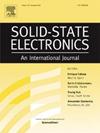SOI量子点中空穴自旋量子比特的模拟:不同几何形状的比较
IF 1.4
4区 物理与天体物理
Q3 ENGINEERING, ELECTRICAL & ELECTRONIC
引用次数: 0
摘要
半导体量子点中的空穴自旋是实现电控量子比特的一种很有前途的途径。这项工作比较了不同纳米线方向的SOI量子点中实现的空穴自旋量子比特的不同几何形状。基于Venitucci等人(2018)的理论,目标是优化几何形状和纳米线方向,以在给定RF驱动幅度下最大化Rabi频率。在基于comsol的框架下,利用k⋅p模型计算孔洞特征函数。利用g矩阵的形式来计算拉比频率作为磁场方向的函数。本文章由计算机程序翻译,如有差异,请以英文原文为准。
Simulation of hole spin qubits in SOI quantum dots: Comparison between different geometries
Hole spins in semiconductor quantum dots are a promising path to implement electrically controlled qubits. This work compares different geometries of hole spin qubits implemented in SOI quantum dots with different nanowire orientations. The goal is to optimize geometry and nanowire orientation to maximize the Rabi frequency for a given RF drive amplitude, based on the theory in Venitucci et al. (2018). The hole eigenfunctions are calculated using the model within a COMSOL-based framework. The -matrix formalism is exploited to compute Rabi frequency as a function of the magnetic field orientation.
求助全文
通过发布文献求助,成功后即可免费获取论文全文。
去求助
来源期刊

Solid-state Electronics
物理-工程:电子与电气
CiteScore
3.00
自引率
5.90%
发文量
212
审稿时长
3 months
期刊介绍:
It is the aim of this journal to bring together in one publication outstanding papers reporting new and original work in the following areas: (1) applications of solid-state physics and technology to electronics and optoelectronics, including theory and device design; (2) optical, electrical, morphological characterization techniques and parameter extraction of devices; (3) fabrication of semiconductor devices, and also device-related materials growth, measurement and evaluation; (4) the physics and modeling of submicron and nanoscale microelectronic and optoelectronic devices, including processing, measurement, and performance evaluation; (5) applications of numerical methods to the modeling and simulation of solid-state devices and processes; and (6) nanoscale electronic and optoelectronic devices, photovoltaics, sensors, and MEMS based on semiconductor and alternative electronic materials; (7) synthesis and electrooptical properties of materials for novel devices.
 求助内容:
求助内容: 应助结果提醒方式:
应助结果提醒方式:


